All 20+ LGBT pride flags and their meanings explained
| Updated on
Flags have been an important rallying symbol for the LGBTQ+ movement, and many of us feel a sense of pride whenever we’re engulfed in a sea of rainbow flags during pride month. But there’s more pride flags than just the rainbow flag, and many of us might struggle to recognise or understand what those flags mean.
In this article, we’ll take a look at all the pride flags out there, and explain their origins and the meanings behind their colours.
Article continues below
Here we go:
- Original Gilbert Baker rainbow pride flag
- LGBTQ+ rainbow pride flag
- Philadelphia People of Colour-Inclusive pride flag
- Progress pride flag
- Abrosexual pride flag
- Agender pride flag
- Aromantic pride flag
- Asexual pride flag
- Bear Brotherhood pride flag
- Bisexual pride flag
- Demiboy pride flag
- Demigirl pride flag
- Demisexual pride flag
- Gay men pride flag
- Genderfluid pride flag
- Genderqueer pride flag
- Intersex pride flag
- Leather, Latex, and BDSM pride flag
- Lesbian Labrys pride flag
- Lesbian pride flag
- Lipstick Lesbian pride flag
- Non-binary (enby) pride flag
- Omnisexual pride flag
- Pansexual pride flag
- Polyamory pride flag
- Polysexual pride flag
- Rubber pride flag
- Straight Ally pride flag
- Transgender pride flag
Article continues below
Original Gilbert Baker rainbow pride flag (8 colours)

Gilbert Baker designed the OG rainbow pride flag in 1978.
Before that, the pink triangle was used as a symbol for the gay community, due to its use by the Nazis during WWII to identify and stigmatise gay people. However, by the 1970s (30 years after the war ended), many felt that the pink triangle reminded them of a dark age, and wanted something that could represent the dawn of a new age. Harvey Milk, then city supervisor of San Francisco, challenged Gilbert Baker to create a new flag for the gay community.
Inspired by Judy Garland’s “Over the rainbow”, Baker designed the first rainbow pride flag, which included 8 colours.
Meaning behind the colours:
- Hot pink represents sex
- Red represents life
- Orange represents healing
- Yellow represents sunlight
- Green represents nature
- Turquoise represents magic / art
- Indigo represents serenity
- Violet represents spirit
LGBTQ+ rainbow pride flag

This is probably the most common LGBTQ+ rainbow pride flag you’ll see these days. This 6-coloured rainbow pride flag is the version that was adopted into emoji form in 2016: 🏳️🌈
In November 1978, Harvey Milk was assassinated by a former supervisor, and became an icon of gay martyrship overnight. Demand for the rainbow pride flag soared, but flag makers at that time had difficulty getting hot pink fabric. Hot pink was thus dropped from the flag in November 1978.
In 1979, the San Francisco pride parade wanted to split the flag into two in order to display each half on one side of the parade route. They needed an even number of colours for that, so turquoise was dropped.
Meaning behind the colours:
- Red represents life
- Orange represents healing
- Yellow represents sunlight
- Green represents nature
- Blue represents serenity
- Purple represents spirit
Check out some related products:
Philadelphia People of Colour-Inclusive pride flag

In June 2017, marketing firm Tierney partnered with the city of Philadelphia to launch the inclusive LGBTQ+ rainbow pride flag. This flag builds on top of the popular 6-coloured rainbow flag, and adds brown and black to raise awareness of the racism that people of colour face within the LGBTQ+ community.
Meaning behind the colours:
- Black and brown represent people of colour
- Red represents life
- Orange represents healing
- Yellow represents sunlight
- Green represents nature
- Blue represents serenity
- Purple represents spirit
Check out some related products:
Article continues below
Progress pride flag

The Progress pride flag was designed by Daniel Quasar in 2018, and features a forward-moving 5-coloured chevron on top of the popular 6-coloured rainbow pride flag.
The 5 new colours added includes black and brown (which represent people of colour) and pink, light blue, and white (which are used in the Transgender pride flag).
Meaning behind the colours:
- Black and brown represent people of colour
- Pink represents the traditional colour for baby girls
- Light blue represents the traditional colour for baby boys
- White represents the lack of gender, a gender beyond the binary, or people who are transitioning
- Red represents life
- Orange represents healing
- Yellow represents sunlight
- Green represents nature
- Blue represents serenity
- Purple represents spirit
Abrosexual pride flag

Abrosexual folks experience a fluid or changing sexual orientation, though it’s important to note that such fluidity can’t typically be controlled. That’s to say, abrosexual folks don’t change their orientation at will or “on a whim”.
The Abrosexual pride flag was introduced in 2013 by an unknown designer on Tumblr, and the meanings behind the colours in the flag remain unknown. Yup, it’s a ✨mystery✨.
Meaning behind the colours: Nobody knows.
Agender pride flag

Agender folks typically experience a lack of gender identity, a gender that is neutral, or a gender that falls beyond the gender binary. The Agender pride flag was designed by Salem X in 2014 on Tumblr, and features 7 horizontal stripes that uses 4 colours.
Meaning behind the colours:
- Black and white represents the absence of gender
- Gray represents being semi-genderless
- Green represents nonbinary genders (because it’s the inverse of purple, which is a colour often associated with the mix of male and female genders)
Check out some related products:
Aromantic pride flag

Aromantic folks generally don’t feel romantic attraction to others, which means they generally don’t desire to be in romantic relationships with people, or engage in romantic acts with others. Aromantic folks can feel sexual attraction and can be of any sexual orientation or gender identity.
Before this aromantic pride flag became popular, 2 other flag designs were proposed. In August 2014, Cameron designed a new version of the aromantic pride flag, which features 5 horizontal stripes of different colours.
Meaning behind the colours:
- Green and light green represents the aromantic spectrum (green is thought to be the opposite of red, a colour commonly associated with romance)
- White represents platonic love and friendships
- Gray and black represents the spectrum of different sexualities
Check out some related products:
Asexual pride flag

Asexual folks generally don’t feel sexual attraction or desire. Asexuality is a spectrum, with a total lack of sexual attraction on one end (asexual), and having sexual attraction on the other (allosexual). Folks who identify in between both ends are known broadly as gray ace, and may feel sexual attraction to some people (e.g. people whom they have emotional relationships with, and not strangers like celebrities or eye candies).
The asexual pride flag was formalised in 2010 after an online vote by members of various asexual communities.
Meaning behind the colours:
- Black represents asexuality
- White represents allosexuality (presence of sexual attraction)
- Gray represents the gray ace folks in the asexual spectrum
- Purple represents community, because the AVEN (Asexual Visibility and Education Network) website had a purple colour scheme
Check out some related products:
Article continues below
Bear Brotherhood pride flag

A bear within gay male culture refers to a large-sized hairier man who projects a sense of “rugged masculinity”. The Bear Brotherhood pride flag was meant to represent the bear subculture within the wider LGBTQ+ community.
The Bear Brotherhood pride flag was designed in 1995 by Craig Byrnes.
Meaning behind the colours:
- Brown, rust / orange, yellow, tan, white, gray, and black represent the different fur colours of different types of bears (the animal)
- A black bear paw print is included at the top left of the flag, to further represent the bear community
Bisexual pride flag

Bisexual folks are attracted to people of the same gender, as well as people of different genders. In other words, they’re attracted to 2 or more genders.
The bisexual pride flag was designed by Michael Page in 1998. He took inspiration from an existing bisexual symbol known as the “biangles” (2 intersecting triangles, one pink and one blue).
Meaning behind the colours:
- Pink represents attraction to the same gender
- Blue represents attraction to people of different genders
- Purple represents attraction to people of the same or different genders
Check out some related products:
Demiboy pride flag
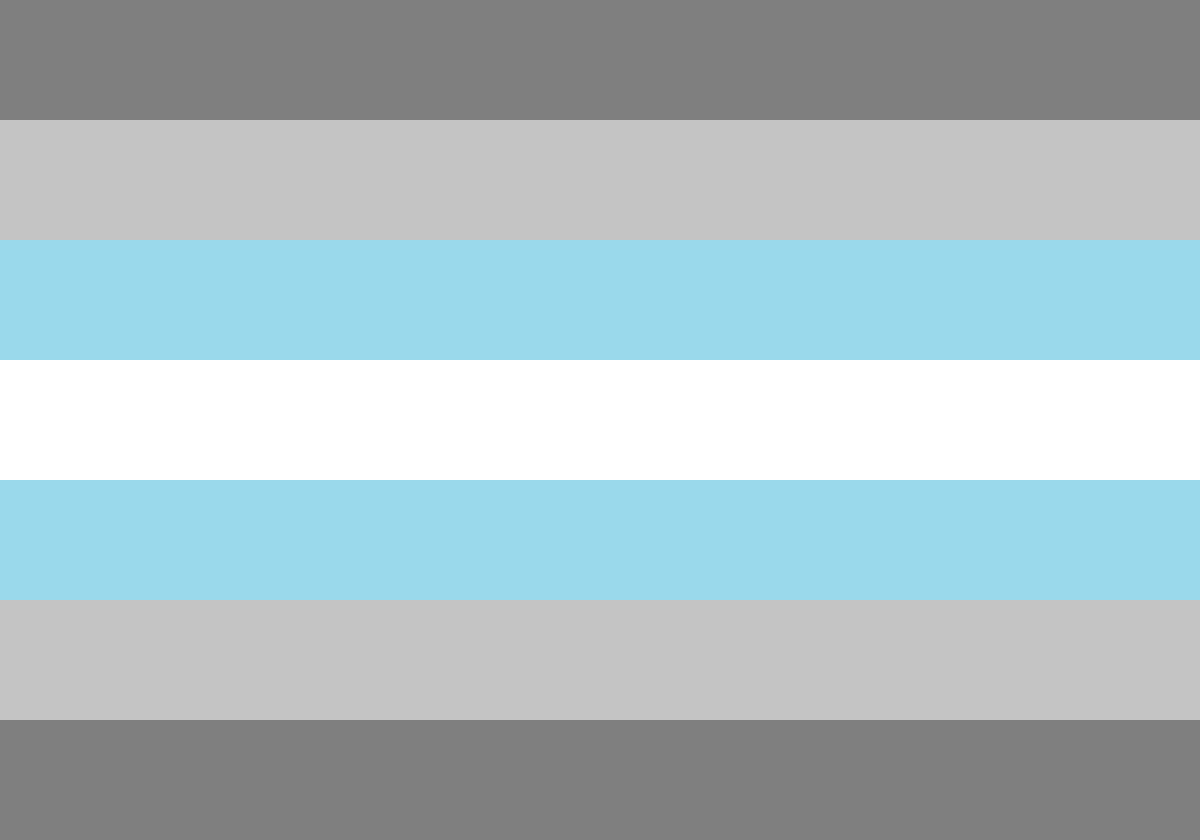
Demiboy folks identify only partially as a boy or man. The demiboy gender is part of the non-binary umbrella, since it doesn’t fit within the binary (male / female) concept of gender. Demiboy folks may or may not identify as another gender on top of partially being a boy or man.
The demiboy pride flag was designed by Tumblr user Transrants in 2015, though the exact meanings behind the colours weren’t explicitly explained.
Meaning behind the colours:
- Blue represents masculinity or manhood
- White represents agender or non-binary identities
- Greys represent partial connections and grey areas
Check out some related products:
Demigirl pride flag

Demigirl folks identify only partially as a girl or woman. The demigirl gender is part of the non-binary umbrella, since it doesn’t fit within the binary (male / female) concept of gender. Demigirl folks may or may not identify as another gender on top of partially being a girl or woman.
The demigirl pride flag was designed by Tumblr user Transrants in 2015, though the exact meanings behind the colours weren’t explicitly explained.
Meaning behind the colours:
- Pink represents femininity or womanhood
- White represents agender or non-binary identities
- Greys represent partial connections and grey areas
Check out some related products:
Article continues below
Demisexual pride flag

Demisexuality falls within the spectrum of asexuality, where an individual doesn’t experience sexual attraction to someone until they’ve formed an emotional connection with them. Because demisexuality falls within asexuality, their flags share the same colours, but come with different shapes.
It’s not known who designed the demisexual pride flag, though it’s believed to be inspired by the asexual pride flag in 2010.
Meaning behind the colours:
- Black represents asexuality
- White represents allosexuality (presence of sexual attraction)
- Gray represents the gray ace folks in the asexual spectrum
- Purple represents community, because the AVEN (Asexual Visibility and Education Network) website had a purple colour scheme
Gay men pride flag

The (cis, white) gay man has always been at the centre of pride movements, but as people opened their minds to include all LGBTQ+ identities in the movement, the rainbow flag increasingly solidified its position as one that represents the entire LGBTQ+ community.
Over time, demand grew for a flag that specifically represents gay men. This 5-coloured (and sometimes 7-coloured) gay men pride flag was designed in 2019 by Tumblr user @gayflagblog, but it wasn’t without controversy.
Accusations that the creator of the flag is transphobic, and that the design was stolen from the sunset lesbian flag, were rampant. However, those claims have since been debunked, and the flag became increasingly accepted within the community.
Meaning behind the colours:
- Turquoise to green colours represent community, healing, and joy
- White represents gender nonconforming, non-binary, and transgender folks
- Blue to purple colours represent pure love, fortitude, and diversity
Check out some related products:
Genderfluid pride flag

Genderfluid people identify with different gender identities over time, and may want to remain flexible about their gender identity instead of committing to a single identity or definition.
The genderfluid identity generally falls under the wider transgender umbrella. The genderfluid flag was designed by JJ Poole in 2012.
Meaning behind the colours:
- Pink represents femininity or feeling female
- White represents lack of gender
- Purple represents a combination of masculinity and femininity and degrees of androgyny
- Black represents all other genders, third genders and pangender
- Blue represents masculinity and feeling male.
Check out some related products:
Genderqueer pride flag

Genderqueer people generally do not subscribe to the gender binary and their norms, but may identify with neither, both or a combination of those genders.
The genderqueer pride flag was designed in 2011 by Marilyn Roxie.
Meaning behind the colours:
- Lavender represents androgyny and queerness
- White represents agender identity or gender neutrality
- Green is the inverse of lavender, and represents those whose identities which are defined outside the binary
Check out some related products:
Intersex pride flag

Intersex people are born with variations in sex characteristics — including chromosomes, gonads, sex hormones, or genitals — which make it difficult to classify them as traditionally male or female. It’s a misconception that all intersex folks have both male and female genitalia; instead, non-physical traits, such as hormonal or chromosomal variations, are much more common.
Intersex folks can have any sexual orientation or gender identity, but are often included in the LGBTQ+ umbrella because they tend to also face discrmination in their daily lives.
The intersex flag was designed in 2013 by Morgan Carpenter of Intersex Human Rights Australia.
Meaning behind the flag:
- Purple and yellow are intentionally used as colours that don’t reinforce gender stereotypes
- The circle symbolises wholeness and completeness
Check out some related products:
Article continues below
Leather, Latex, and BDSM pride flag

While not representing any specific sexual orientation or gender identity, this flag has been used by the leather subculture since the 90s and was quickly embraced by the gay leather community, signifying pride for the BDSM and fetish subculture.
This flag was designed by Tony DeBlase in 1989, who was repeatedly asked to explain the meaning behind the colours and design, but refused. In his words: “I will leave it to the viewer to interpret the colors and symbols”.
Meaning behind the colours: Nobody knows. Either that, or everyone’s own interpretation is correct.
Lesbian Labrys pride flag

This flag was designed in 1999 by Sean Campbell for the lesbian community, but hasn’t gained widespread adoption. Part of the reason could be because the flag was designed by a gay man, and not a lesbian.
Some transphobic camps have attempted to claim the labrys as a symbol for their campaigns, but the origins of this pride flag was never grounded in transphobia.
Meaning behind the flag:
- The labrys is a mythical weapon used by the Amazons, which has been adopted by feminists since the 70s as a symbol of empowerment
- The black inverted triangle calls back to the time when Nazis captured homosexual women and labelled them with black triangles for being “asocial”
- The violet background was associated with lesbians due to the poetry of Sappho
Lesbian pride flag

This lesbian pride flag was designed by Emily Gwen in 2018, and became the most popular and recognised flag for the community. A 5-coloured version is also commonly used, where the middle orange and middle pink shades are removed.
Meaning behind the colours:
- Dark orange represents gender nonconformity
- Orange represents independence, both as a concept in itself, and as a form of independence from men
- Light orange represents community
- White represents the unique connection to womanhood that lesbians experience
- Light pink represents serenity and peace
- Pink represents love and sex
- Dark pink represents femininity
Check out some related products:
Lipstick Lesbian pride flag

“Lipstick lesbian” is a slang for more feminine-presenting lesbians, who may use make-up (lipstick), wear dresses, and so on. The term has been used since the 80s, and gained popularity by the 90s.
In 2010, Natalie McCray published the lipstick lesbian pride flag, which was meant to represent the lipstick lesbian sub-group. However, claims of plagiarism were made against this flag design, which looked uncannily similar to the Cougar pride flag designed by Fausto Fernós in 2008.
McCray was also accused of holding transphobic and exclusionist ideals, and her flag design was quickly dropped by most people within the community. The colours in her flag weren’t explained.
Meaning behind the colours: Nobody knows.
Article continues below
Non-binary (enby) pride flag

Non-binary folks have gender identities that fall beyond the gender binary (male / female). This includes folks who are agender (who typically don’t experience a gender), multi-gender (who experience more than 1 gender), genderfluid (who experiences different genders), and who experience genders that are outside of the male/female classification.
The non-binary flag was designed by Kye Rowan in 2014.
Meaning behind the colours:
- Yellow represents being outside the binary
- White represents all genders, since white is the presence of all light in the visible spectrum
- Purple represents fluidity and multiplicity of many gender experiences, the uniqueness and flexibility of non-binary people, as well as those whose gender experiences include being of or between female and male
- Black represents the absence of gender, since black is the absence of all light in the visible spectrum
Check out some related products:
Omnisexual pride flag

Omnisexual folks are attracted to people of all genders, where gender still plays a role in their attraction to a person.
The omnisexual pride flag was designed by @pastelmemer in 2015, though the exact meaning of the colours isn’t really explained.
Meaning behind the colours:
- Light pink and light blue represent the gender spectrum
- Pink represents attraction to femininity and women
- Blue represents attraction to masculinity and men
- Dark purple represents attraction to people whose gender falls outside of the categories above
Check out some related products:
Pansexual pride flag

Pansexual folks are attracted to people of all genders, where gender isn’t a factor in their attraction to a person.
The pansexual pride flag was designed by Jasper in 2010.
Meaning behind the colours:
- Pink represents attraction to women
- Yellow represents attraction to non-binary folks
- Blue represents attraction to men
Check out some related products:
Polyamory pride flag

Polyamory refers to the ability and desire to be in a consensual relationship with more than one person at once. This is very distinct from cheating, which is non-consensual and unethical.
The polyamory pride flag was designed by Jim Evans in 1995.
Meaning behind the flag:
- Blue represents the openness and honesty among all partners
- Red represents love and passion
- Black represents solidarity with those who are forced to hide their polyamorous relationships from the outside world due to societal pressures
- The pi (π) symbol is a Greek letter, and makes reference to the fact that “polyamory” also starts with “p”
- Gold in the pi symbol represents the value placed on emotional attachment, not just physical attraction
Check out some related products:
Article continues below
Polysexual pride flag

Polysexual folks are attracted to multiple genders, i.e. to 2 or more genders.
The polysexual pride flag was designed by Samlin in 2012.
Meaning behind the colours:
- Pink represents attraction to women
- Blue represents attraction to men
- Green represents attraction to non-binary folks
Rubber pride flag

While not representing any specific sexual orientation or gender identity, this flag represents the rubber or latex fetish subculture in the LGBTQ+ community.
The flag was designed by Peter Tolos and Scott Moats in 1995.
Meaning behind the flag:
- Black represents desire for the latex / rubber look and feel
- Red represents passion for rubber and rubbermen (a term used to describe gay men with a fetish for rubber)
- Yellow represents a drive for intense rubber play and fantasies
- The kink in the bands of colour represents the fact that rubber fetish is a kink
Straight Ally pride flag

This flag was specifically designed for straight allies to wear or wave at pride parades, without presenting themselves as queer.
The straight ally pride flag was designed in the late 2000s, although the origin is unknown.
Meaning behind the flag:
- The “A” shape represents allyship
- The rainbow colours in the “A” shape represents solidarity with the LGTBQ+ community
- The black and white stripes represent straight and/or cisgender allies
Check out some related products:
Transgender pride flag

Transgender folks don’t identify as the gender assigned to them at birth (by doctors and/or their parents). It’s now used as an umbrella term to include non-binary and genderqueer folks as well, though not all of them prefer to use the “transgender” label.
The transgender pride flag was designed in 1999 by Monica Helms, a trans woman.
Meaning behind the colours:
- Blue is the traditional colour used for baby boys, and represents masculinity
- Pink is the traditional colour used for baby girls, and represents femininity
- White represents non-binary, transitioning, and intersex folks
Check out some related products:
Article continues below














































































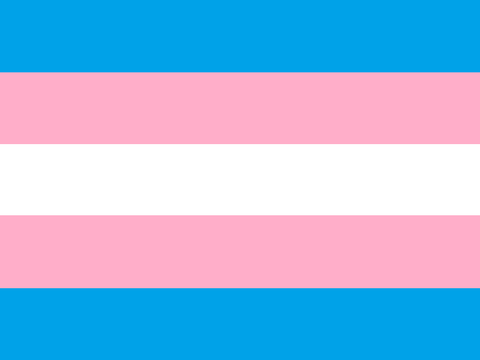
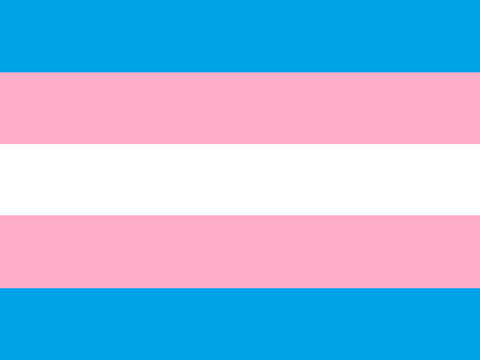

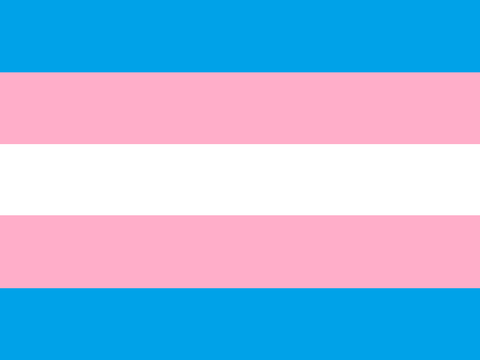
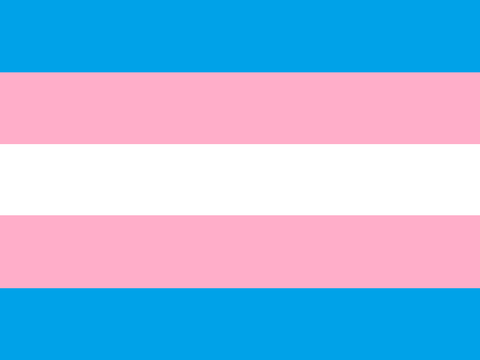
This is awesome, I mean this is sooooo helpful!!!